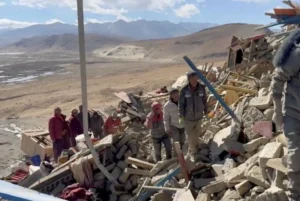At Least 126 People Are Killed and Many Are Trapped by the Tibet Earthquake
A strong earthquake that slammed a high-altitude area of western China and parts of Nepal on Tuesday caused extensive damage, killed at least 126 people in Tibet, and stranded several others. Hundreds of residences suffered significant damage as a result of the earthquake, and the streets were covered in debris and rubble. The already isolated area was still being rocked by dozens of tremors.
Rescue crews put in endless hours hunting for survivors by navigating through the destroyed towns on ladders and scaling heaps of shattered bricks. Workers were seen on stretchers carrying injured people across the crumbled remnants of houses in footage from China’s Ministry of Emergency Management.
At least 188 people were hurt in Tibet on the Chinese side of the border, according to the official Xinhua News Agency. More than 1,000 homes have been damaged in the thinly inhabited and desolate area, according to state television CCTV. CCTV footage showed roads clogged with debris from demolished buildings, with crushed cars among the debris.
According to Nepal’s National Emergency Operation Center, although early reports showed minimal damage or injuries, people in northeastern Nepal felt the tremors severely. Because so many people flee to avoid the cold, the area around Mount Everest, which is roughly 75 kilometers (50 miles) southwest of the epicenter, was mainly deserted during the winter.
Residents of Kathmandu, the capital of Nepal, which is roughly 230 kilometers (140 miles) from the epicenter, were startled by the earthquake and fled into the streets in fear.
According to the U.S. Geological Survey, the earthquake had a magnitude of 7.1 and was only around 10 kilometers (6 miles) deep. The magnitude was 6.8, according to the China Earthquake Networks Center. More damage is typically caused by shallow earthquakes.
The earthquake’s epicenter was in Tibet’s Tingri County, where the tectonic plates of India and Eurasia meet. This region frequently experiences strong earthquakes that have the capacity to change the elevation of the tallest Himalayan peaks in the world.
Many Tibetans are loyal to the Dalai Lama, their spiritual leader who has been living in exile in India since the failed anti-Chinese rebellion in 1959, despite Tibet being a part of China. Western countries and human rights organizations have criticized the Chinese government for its policies in Tibet, which include significant financial investment and a harsh crackdown on opposition.
According to the U.S. Geological Survey, the area has seen 10 earthquakes of a magnitude of at least 6 in the last century.
About 150 aftershocks were registered in the nine hours after the earthquake. As a precaution, the picturesque area on the Chinese side of Mount Everest was blocked.
Chinese President Xi Jinping urged immediate rescue operations, emphasizing the need to reduce the number of victims and relocate those whose homes were damaged. CCTV reports that about 3,000 rescue personnel were sent to the area.
The Chinese government provided disaster relief with 100 million yuan, or roughly $13.6 million, and deployed Vice Premier Zhang Guoqing to supervise the efforts.
On the Chinese side, there are about 6,900 people living in the three townships and 27 villages that are 20 kilometers (12.5 miles) from the epicenter. The Chinese earthquake center estimates that the average elevation in the region is 4,200 meters (13,800 feet).
Water was seen spilling from a pond in a courtyard close to a small shrine in a video taken from Kathmandu’s southwest side. “It’s a big earthquake,” a woman can be heard saying in the footage. Everyone is trembling.

The latest news and breaking news today : bravenewclimate
Source : apnews






.png)





